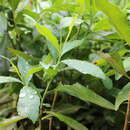en
names in breadcrumbs


Warburgia ugandensis, ye una especie d'árbol de fueya perenne orixinariu d'África.
Ye un árbol qu'algama un tamañu d'hasta 42 m d'altor, pero de cutiu ye bastante pequeñu (± 5 m).
Alcuéntrase nel monte tropical de tierres baxes, monte siempreverde secu en tierres altes y les sos reliquies en carbes secundaries y pacionales, llombes de termites y nel monte de banzáu; a una altitú de 800-1100-2400 msnm. (N'África oriental)[1]
La madera ye resistente al ataque d'inseutos[2] y bien fuerte. Utilízase comúnmente pal xugu de carros tiraos por gües. Los primeres inmigrantes indios a Kenia, trabayando na construcción de la vía ferrial, utilicen les fueyes p'arumar les sos curries enantes de la introducción xeneral de la planta de chili. El sabor ye intensamente caliente y sutilmente distintu a los chiles.
Los estractos de W. ugandensis fueron reportaos p'amosar delles propiedaes antipalúdicas, antifúngicas y antibacterianas in vitro o en modelos animales.[3]
Sobrar esplotación insostenible de la corteza amenorgó la población de la subespecie longiflora a la Reserva Forestal Rondo en Tanzania, lo que llevó a la UICN a la llista como vulnerable na Llista Colorada d'Especies Amenaciaes.
Warburgia ugandensis describióse por Thomas Archibald Sprague y espublizóse en Journal of the Linnean Society, Botany 37: 498. 1906.[4]
 Esta páxina forma parte del wikiproyeutu Botánica, un esfuerciu collaborativu col fin d'ameyorar y organizar tolos conteníos rellacionaos con esti tema. Visita la páxina d'alderique del proyeutu pa collaborar y facer entrugues o suxerencies.
Esta páxina forma parte del wikiproyeutu Botánica, un esfuerciu collaborativu col fin d'ameyorar y organizar tolos conteníos rellacionaos con esti tema. Visita la páxina d'alderique del proyeutu pa collaborar y facer entrugues o suxerencies. Warburgia ugandensis, ye una especie d'árbol de fueya perenne orixinariu d'África.
Warburgia ugandensis, also known as Ugandan greenheart or simply greenheart tree, is a species of evergreen tree native to East Africa. Countries in which the plant species is found include Kenya, Tanzania and Uganda. The wood is resistant to insect attack[1] and very strong. It was commonly used for the yoke pole of ox-wagons, the Disselboom. Early Indian immigrants to Kenya, working on the construction of the railway, used the leaves to flavor their curries before the chilli plant was commonly introduced. The flavor is hot and subtly different from chillies.
Extracts of W. ugandensis have been reported to show some antimalarial, antifungal, and antibacterial properties in vitro or in animal models.[1][2]
Unsustainable overharvesting of the bark reduced the population of the longifolia subspecies to the Rondo Forest Reserve in Tanzania, which prompted the IUCN to list it as vulnerable in its Red List of Threatened Species.[3]
Warburgia ugandensis, also known as Ugandan greenheart or simply greenheart tree, is a species of evergreen tree native to East Africa. Countries in which the plant species is found include Kenya, Tanzania and Uganda. The wood is resistant to insect attack and very strong. It was commonly used for the yoke pole of ox-wagons, the Disselboom. Early Indian immigrants to Kenya, working on the construction of the railway, used the leaves to flavor their curries before the chilli plant was commonly introduced. The flavor is hot and subtly different from chillies.
Extracts of W. ugandensis have been reported to show some antimalarial, antifungal, and antibacterial properties in vitro or in animal models.
Unsustainable overharvesting of the bark reduced the population of the longifolia subspecies to the Rondo Forest Reserve in Tanzania, which prompted the IUCN to list it as vulnerable in its Red List of Threatened Species.
Warburgia ugandensis es una especie de árbol de hoja perenne originario de África.
Es un árbol que alcanza un tamaño de hasta 42 m de altura, pero a menudo es bastante pequeño (± 5 m).
Se encuentra en el bosque tropical de tierras bajas, bosque siempreverde seco en tierras altas y sus reliquias en matorrales secundarios y pastizales, colinas de termitas y en el bosque de pantano; a una altitud de 800-1100-2400 msnm. (En África oriental)[1]
La madera es resistente al ataque de insectos[2] y muy fuerte. Se utiliza comúnmente para el yugo de carros tirados por bueyes. Los primeros inmigrantes indios a Kenia, trabajando en la construcción de la vía férrea, utilizan las hojas para aromatizar sus curries antes de la introducción general de la planta de chili. El sabor es intensamente caliente y sutilmente diferente a los chiles.
Se ha reportado que los extractos de W. ugandensis presentan algunas propiedades antipalúdicas, antifúngicas y antibacterianas in vitro o en modelos animales.[3]
La sobre explotación insostenible de la corteza redujo la población de la subespecie longiflora a la Reserva Forestal Rondo en Tanzania, lo que llevó a la UICN a la lista como vulnerable en la Lista Roja de Especies Amenazadas.
Warburgia ugandensis fue descrita por Thomas Archibald Sprague y publicado en Journal of the Linnean Society, Botany 37: 498. 1906.[4]
Warburgia ugandensis es una especie de árbol de hoja perenne originario de África.